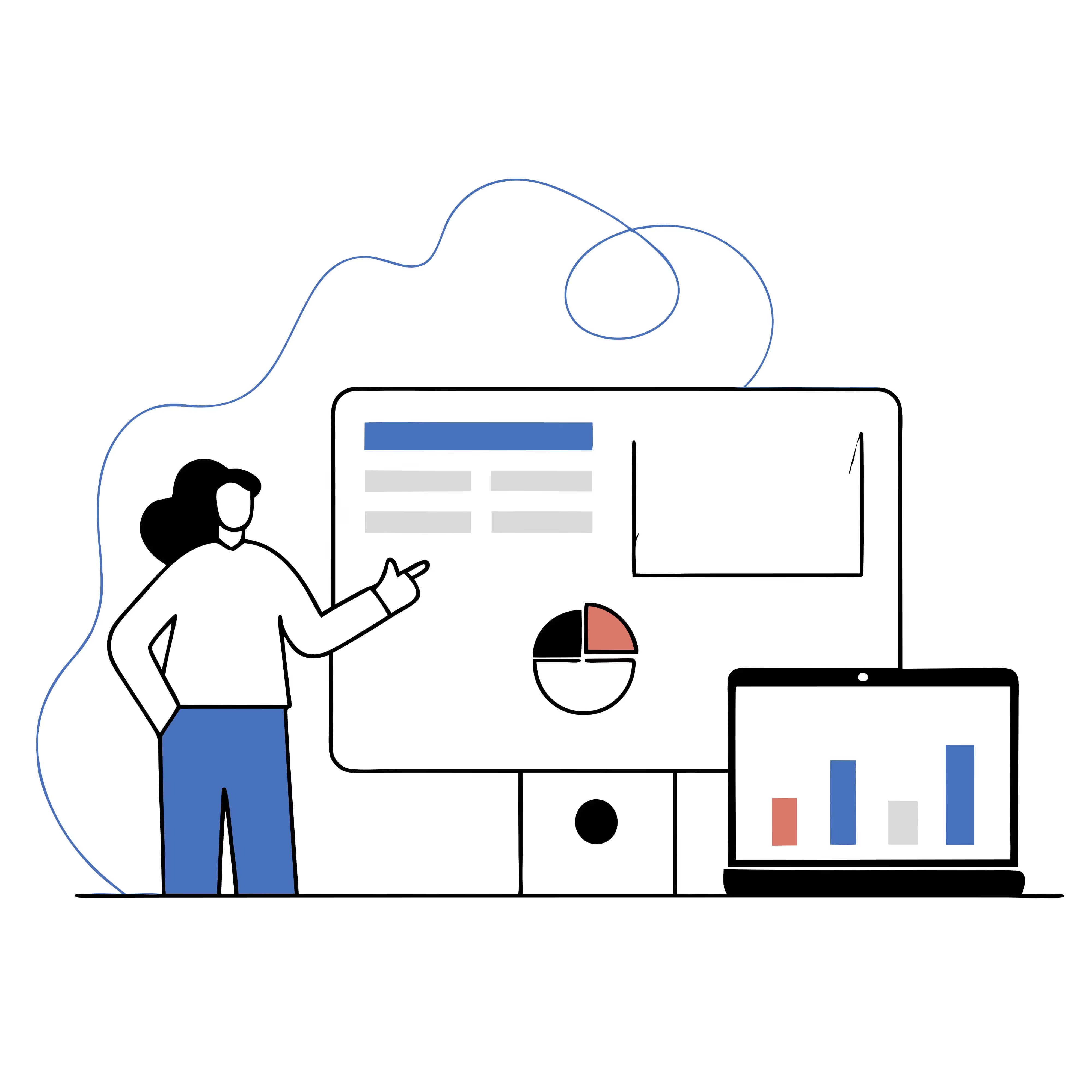B2B prospecting involves finding potential business clients who can benefit from your products or services. It’s crucial for filling your sales pipeline with qualified leads and driving business growth. In this article, we’ll dive into proven techniques for effective B2B prospecting. From identifying your ideal customer profile to leveraging technology, these strategies will help you connect with the right prospects and boost your sales pipeline.
Key Takeaways
- Effective B2B prospecting is about building relationships through collaboration between sales and marketing teams to identify and nurture high-quality leads.
- Creating a detailed Ideal Customer Profile (ICP) and regularly updating it allows businesses to focus their prospecting efforts where they are most likely to yield results.
- Leveraging technology and measuring key metrics is essential for optimizing sales prospecting strategies, ensuring continuous improvement, and maximizing efficiency.

Understanding B2B Prospecting
B2B prospecting is the process of searching for new customers in the business-to-business market. It is the lifeblood of sales and marketing teams, driving business growth by connecting organizations with potential buyers who can benefit from their products or services. Imagine a sales rep equipped with a treasure map, seeking out the most promising prospects in a vast sea of potential business customers. This is the essence of B2B sales prospecting.
The ultimate goal of B2B prospecting is to identify qualified leads and convert them into revenue-generating accounts. Effective execution can lead to substantial business growth. It’s like planting seeds in fertile ground; with the right care and attention, these seeds will grow into fruitful business relationships. Conducted properly, B2B prospecting allows organizations to build long-term client relationships through continuous engagement.
Collaboration between sales and marketing teams is crucial in this endeavor. Sales teams rely on marketing teams to raise awareness of their products and services, while marketing teams depend on sales teams to convert prospects into customers. This symbiotic relationship enhances the efficiency of prospecting efforts, ensuring a steady stream of qualified leads.
Whether through outbound prospecting or inbound strategies, the goal remains the same: to fill the sales funnel with high-quality leads that can be nurtured into loyal customers.
Identifying Your Ideal Customer Profile (ICP)
An Ideal Customer Profile (ICP) is a detailed description of the type of business that stands to gain the most from your product or service. Think of it as a blueprint for your prospecting efforts, guiding you towards the potential clients who are most likely to convert into long-term customers. Defining an ICP helps in narrowing down potential leads to those who are the best fit, optimizing the sales process and increasing efficiency.
The process of creating an ICP begins with analyzing your existing successful customers to identify common traits. This involves using firmographic data such as industry, company size, and location to build a comprehensive profile of your ideal customer. Additionally, intent data can reveal insights into user behavior, helping you understand which companies align with your ICP and are actively seeking solutions like yours.
Updating your ICP regularly in response to market changes and customer feedback maintains its effectiveness. A well-defined ICP not only enhances collaboration between product, sales, and marketing teams but also ensures that all efforts are aligned towards customer acquisition.
Nailing your buyer persona and ICP early supports both inbound and outbound efforts, ensuring a steady flow of qualified prospects.

Building a Targeted Prospect List
Building a targeted prospect list is a fundamental step in the prospecting process. This list serves as a roadmap for sales reps, guiding their outreach efforts towards potential customers who are most likely to be interested in their offerings. The use of sales intelligence platforms like Firmable can provide comprehensive data, making it easier to identify and prioritize high-quality leads.
Segmenting the prospect list based on shared characteristics helps prioritize outreach efforts, ensuring that sales reps focus on the most promising prospects. This segmentation can be based on factors such as industry, company size, and geographic location. Regularly validating and updating the prospect list maintains its accuracy and relevance, preventing wasted efforts.
Syncing prospect lists to your CRM streamlines outreach and eases follow-ups, ensuring no potential lead slips through the cracks. A well-maintained and updated prospect list enhances sales team efficiency and effectiveness, driving more successful B2B prospecting outcomes.
Conducting Effective Research on Prospects
Conducting thorough research on prospects before initiating contact can dramatically enhance engagement rates. It’s like studying a map before embarking on a journey; the more you know about the terrain, the better prepared you are. In B2B prospecting, understanding a prospect’s identity, business, and industry is crucial for effective outreach. This research enables sales reps to tailor their communication to address specific needs and challenges.
Various research methods can be employed to gather detailed insights. Utilizing social media platforms, industry reports, and online databases can provide valuable information about a prospect’s business model, recent news, and industry challenges. Understanding the job roles, responsibilities, and motivations of decision-makers within the prospect’s organization further enhances the personalization of outreach efforts.
Personalized outreach based on thorough research can significantly enhance the effectiveness of cold email campaigns and other outreach methods. Gathering detailed insights and preparing for discovery calls helps sales reps establish trust and credibility, increasing the chances of successful engagements.

Initiating Contact with Prospective Customers
Initiating contact with prospective customers is a pivotal step in the B2B sales process. Personalization and thorough research can significantly improve the results of cold calling and other outreach methods. Imagine starting a conversation with a prospect by addressing their specific needs and pain points—this approach can set the stage for a meaningful engagement. The goal of the initial phone call or email should be to deliver a relevant pitch and explore the prospect’s initial interest in a cold call.
Various outreach methods can be employed, including cold calls, cold emailing, and social selling. Each method has its own benefits and can be used in different scenarios. Cold email outreach, for example, is scalable and less intrusive than cold calling, offering flexibility in communication. On the other hand, cold calling allows for immediate interaction and feedback, making it an effective strategy for initiating contact with prospects.
Maintaining a personal tone in emails, calls, or social media interactions enhances engagement and builds rapport with prospective customers. Mixing up types of messaging, such as using voice notes or video, can make communication more engaging and effective.
Focusing on prospect benefits and using a well-researched approach significantly improves initial sales prospecting techniques outreach efforts.
Personalizing Outreach Efforts
Personalization is essential in B2B prospecting as it helps stand out and resonate with potential clients. Think of it as crafting a tailor-made suit; the better the fit, the more impressive the result. Personalized outreach strengthens emotional connections and increases engagement rates, making prospects more likely to respond positively to your messages.
Various personalization strategies can be employed to enhance outreach efforts. Email personalization, for instance, captures attention and significantly increases response rates. Establishing a personal brand on social media platforms helps build trust and credibility, making prospects more receptive to your outreach. Additionally, sending personalized direct mail or handwritten notes can be a creative strategy to engage prospects and make your messages more memorable.
Creative outreach methods like sending personalized gifts or joining referral networking programs can further enhance your prospecting efforts. Identifying relevant connection points and tailoring messaging to specific needs enhances communication with potential business customers.
.avif)
Following Up and Nurturing Leads
Following up and nurturing leads is a critical aspect of the prospecting process. Most meetings are booked through follow-ups, and 50% of sales happen after the fifth contact. Imagine nurturing a plant; regular watering and care are essential for it to grow and thrive. Similarly, maintaining contact with leads helps nurture relationships and keeps your brand top-of-mind for potential customers.
Effective follow-ups involve timely communication, personalization, and a recap of past interactions. Asking prospects for their preferred contact method can enhance the likelihood of receiving responses to follow-ups. Creating follow-up templates can save time while still allowing for personalization based on previous interactions.
Automation of follow-up sequences can ensure regular engagement with prospects while reducing manual effort. An effective follow-up after a discovery call should include a thank-you email that summarizes key points and outlines agreed next steps. Strong, personalized follow-ups significantly increase the chances of converting prospects into qualified leads.
Qualifying Prospects Effectively
Qualifying prospects effectively is crucial for ensuring that sales reps invest their time in leads that are most likely to convert. It’s like sifting through a pile of sand to find gold nuggets; only the most promising prospects should move forward in the sales pipeline. Understanding a prospect’s needs and determining whether your offering is the right match for their challenges is a key qualification step.
Assessing a prospect’s budget, timeline, and level of influence is essential for effective qualification. This information helps prioritize follow-up efforts and ensures that sales reps focus on high-quality qualified lead that have the potential to convert into long-term customers. Lead scoring can further assist in prioritizing prospects based on their fit with the Ideal Customer Profile (ICP) and their level of engagement.
By pre-qualifying leads, sales teams can identify unsuitable prospects early on, allowing them to focus their efforts on the most promising opportunities. This approach not only saves time but also increases the efficiency and effectiveness of the sales prospecting process, ultimately leading to better business outcomes.

Scheduling Discovery Calls or Meetings
Scheduling discovery calls or meetings is an essential step in moving interested prospects to deeper conversations. The primary objective of these calls is to assess the fit between the prospect’s needs and your solution. Think of it as a first date; it’s an opportunity to get to know each other and see if there’s potential for a long-term relationship.
A discovery call should typically last between 15 to 30 minutes, allowing enough time to ask questions and explore the prospect’s challenges. During this call, it’s crucial to listen actively and ask open-ended questions to uncover the prospect’s pain points and goals. This approach not only helps in understanding their needs but also builds trust and shows that you are genuinely interested in helping them solve their problems.
At the end of the discovery call, it’s important to recap the information gathered and confirm the next steps with the prospect. This could involve scheduling a follow-up meeting, providing additional information, or preparing a customized proposal. By ensuring a clear path forward, you keep the momentum going and increase the likelihood of moving the prospect further down the sales funnel.
Handling Objections and Building Trust
In B2B prospecting, handling objections effectively is crucial for building trust and advancing the sales process. Objections are the reasons prospects give for not wanting to continue the conversation, and addressing these concerns promptly can solidify trust in your solution. Common objections often revolve around pricing, product relevance, or existing competition.
Using a structured approach to handle objections can make a significant difference. This involves listening actively to the prospect’s concerns, acknowledging them, and then providing a well-thought-out response. By showing that you understand their worries and have solutions to address them, you foster a sense of being understood, which increases the likelihood of a sale.
Building trust with prospects involves selling solutions, not just products. This means focusing on how your offering can solve their specific problems and improve their business outcomes. Effective objection handling can turn potential roadblocks into opportunities, ultimately helping you close the deal and build long-term, genuine relationships with your clients.

Closing Deals and Transitioning to Sales Teams
Once a prospect is qualified and their objections have been effectively handled, the next step is transitioning them to the sales team for negotiation and deal closing. This transition is akin to passing the baton in a relay race; smooth handovers are crucial for maintaining momentum and ensuring successful deal closures.
Sales development representatives (SDRs) play a key role in this process. They need to ensure a seamless handoff of leads to account executives (AEs) who will take over the negotiation and closing of the transaction. Effective communication during this transition is vital to ensure that all relevant information about the prospect is conveyed, allowing the sales team to pick up where the sales development rep left off.
Successful negotiation often involves understanding the prospect’s needs and having clear pricing structures ready. Maintaining a collaborative approach and focusing on the prospect’s goals helps close deals efficiently and transitions prospects into satisfied customers.
Leveraging Technology for Prospecting
Leveraging technology in B2B prospecting can significantly enhance efficiency and effectiveness. Sales prospecting tools enable teams to engage with a broader range of potential clients, increasing their chances of finding viable leads. Imagine having a powerful engine that drives your sales prospecting technique, allowing you to cover more ground with less effort.
Sales automation tools help streamline outreach by automating tasks like follow-ups and lead tracking. These tools not only save time but also allow for personalized outreach at scale, making it easier to connect with prospective customers on a deeper level. For instance, tools like Leadspicker can automate lead generation and outreach, achieving results five times faster and saving up to 80% of time and resources.
Selecting the right tools is crucial for maximizing the benefits of technology in prospecting. Tools like Leadspicker enhance the prospecting process by automating data entry, research, and outreach workflows, enabling sales reps to focus on delivering relevant and personalized communication. Leveraging technology boosts productivity, enhances customer engagement, and drives better outcomes in the sales pipeline.
Measuring Success in B2B Prospecting
Measuring success in B2B prospecting is essential for understanding the effectiveness of your efforts and making necessary adjustments. Tracking relevant metrics throughout the prospecting process helps determine what’s working and what’s not. Think of it as a feedback loop; by continuously monitoring performance, you can refine your strategies and improve results.
Setting SMART goals—Specific, Measurable, Actionable, Realistic, and Time-Bound—ensures that your prospecting efforts are aligned with your business objectives. Both sales and marketing teams should understand these metrics to ensure a unified approach towards achieving common goals. Metrics such as conversion rates, response rates, and the number of qualified leads generated are crucial for assessing the success of your prospecting efforts.
Continuously improving the prospecting process based on performance analysis is key to long-term success. A daily game plan helps focus on which prospecting methods to use effectively, ensuring that your efforts are targeted and efficient. Measuring success and making data-driven decisions optimizes your prospecting strategy and drives significant business growth.

Summary
In summary, effective B2B prospecting is the cornerstone of a robust sales pipeline. By understanding the fundamental principles of prospecting, identifying your Ideal Customer Profile, and building targeted prospect lists, you lay a strong foundation for success. Conducting thorough research on prospects, personalizing outreach efforts, and following up diligently are essential steps in nurturing leads and moving them through the sales funnel.
Handling objections effectively and building trust with prospects can turn potential roadblocks into opportunities, ultimately leading to successful deal closures. Leveraging technology and measuring success through relevant metrics further enhances the efficiency and effectiveness of your prospecting efforts.
Implementing these strategies will not only boost your sales pipeline but also foster long-term relationships with your clients. So, take these insights, refine your approach, and embark on a journey towards greater business growth and success.
Frequently Asked Questions
What is B2B prospecting?
B2B prospecting is all about finding new business customers and turning them into valuable accounts. Keep pushing forward to identify those qualified leads that will drive your success!
How do you create an Ideal Customer Profile (ICP)?
To create an Ideal Customer Profile (ICP), start by analyzing your most successful customers to spot common traits and use firmographic and intent data for insights. Keep refining your ICP based on market changes and customer feedback to stay aligned with your ideal audience.
What are some effective methods for initiating contact with prospective customers?
To successfully initiate contact with prospective customers, focus on cold calling, cold emailing, and social selling, while ensuring your approach is personalized and well-researched. This will boost your engagement rates and set the stage for meaningful connections.
Why is follow-up important in B2B prospecting?
Follow-up is essential in B2B prospecting because it significantly boosts your chances of closing a deal; remember, 50% of sales occur after the fifth contact. By staying timely and personalized in your approach, you nurture those valuable relationships that lead to success.
How can technology enhance B2B prospecting efforts?
Embracing technology in B2B prospecting can greatly enhance your efforts by automating lead generation and enabling personalized outreach at scale. With tools like sales automation software and lead generation tools, you can save time and work more efficiently, making your prospecting process more effective than ever! There are many tools great for B2B sales prospecting suitable for marketing and sales teams - like Leadspicker, which combines both.


.jpg)



